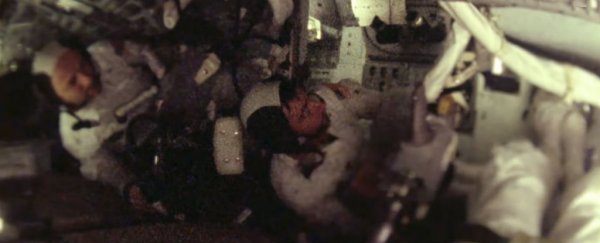In May 1969, three NASA astronauts were circling the Moon on what would be the last mission before Neil Armstrong and Buzz Aldrin walked on its surface a few months later. When the astronauts paused on the far side of the Moon, they heard strange, unexplained noises that they described as "outer space-type music".
Now, the audio recordings of the event have resurfaced, and you can listen to them in full online. "You hear that? That whistling sound?" Apollo 10 astronaut Eugene Cernan asks his crewmates. "Boy, that sure is weird music."
The full transcript of the encounter has been publicly available since 1973, but the audio has gone largely unnoticed until this weekend, when it was featured in the new Discovery series, NASA's Unexplained Files (watch below).
What's perhaps even more remarkable than hearing this 'space music' for the first time is seeing how freaked out the Apollo 10 astronauts, Thomas Stafford, John Young, and Eugene Cernan, were about what they heard:
Cernan: "You know that was funny. That's just like something from outer space, really. Who's going to believe it?"
Young: "Nobody. Shall we tell them about it?"
Cernan: "I don't know. We ought to think about it some."
If you read the full transcript, at different points in the conversation, both Cernan and Young lament that, "No one will believe us."
Why would they even hesitate sharing what they heard with mission control? Quite rightly, NASA puts the safety of its astronauts above all else, and back then, even the most subtle signs of psychological troubles could see a mission instantly aborted.
"Many astronauts and test pilots adopted a 'lie to fly' policy, knowing that the slightest crack in their steely demeanor might be enough for NASA to ground them forever," Sean O'Kane writes for The Verge.
"The thing is, no matter how prepared you might be for a trip into outer space, the smallest things can weigh heavily on your mind. And when you consider that the Apollo 10 astronauts were, at the time, the farthest point away from Earth (about 220,820 nautical miles, a record that stands to this day), it's not hard to imagine why they reacted the way they did," he adds.
Fortunately, the Apollo 10 astronauts weren't crazy, and they definitely weren't hearing things as they hovered so far from home, an entire Moon sat between them and Earth. But just because the 'music' really did happen doesn't make it easy to explain.
One explanation given by the Discovery documentary is that charged particles could have been causing interference in the radio communications - something NASA has recorded more recently via the Cassini spacecraft's orbit of Saturn. But the problem with this hypothesis is pretty simple: unlike Saturn, the Moon has no atmosphere or magnetic field, so charged particles couldn't have been making transmissions that can be picked up on a radio.
Right now, the best explanation we have is that because the sound was heard for about an hour as the team practised the separation and re-docking of the lunar module and command module in preparation for July 21's planned Moon landing, the 'music' was actually just interference between the two modules' radios.
"The radios in the two spacecraft [the lunar module and the command module] were interfering with each other, and that was the source of the sound," space historian Andrew Chaikin tells Discovery in the video below.
But Apollo 15 astronaut, Al Worden, disagrees: "The Apollo 10 crew was very used to the kind of noise that they should be hearing. Logic tells me that if there was something recorded on there, then there was something there."
Months later, something similar was heard by the astronauts that actually landed on the Moon, and unlike Worden, the Apollo 11 pilot that got them there, Michael Collins, was satisfied with the radio interference explanation.
"Had I not been warned about it, it would have scared the hell out of me," he wrote in his book, Carrying the Fire: An Astronaut's Journeys. "Fortunately, the radio technicians (rather than the UFO fans) had a ready explanation for it: it was interference between the LM's and Command Module's VHF radios."
Watch the clip below, and read the full transcript online here.
